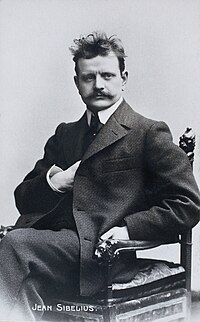|
Snöfrid
Snöfrid, Op. 29, is a melodrama or "improvisation for narrator, mixed choir and orchestra"[3] by Jean Sibelius. He completed it in 1900 on a text by Viktor Rydberg. It was first performed in Helsinki on 20 October 1900, with the Orchestra of the Helsinki Philharmonic Society, conducted by the composer.[2] Instrumentation Snöfrid is scored for the following instruments and voices,[2] organized by family (vocalists, woodwinds, brass, percussion, and strings):
HistoryThe poem had previously been set in full by Wilhelm Stenhammar (Op. 5) in 1891.[4] Sibelius composed the work in the fall of 1900 on a poem by Viktor Rydberg. He later noted: "I wrote Snöfrid more or less at one sitting after I came home from three days of lively celebrations."[3] The plot on which it is based is inspired by old Scandinavian balladic stories. A female protagonist appeals to her compatriots, in particular a hero, to fight for freedom as a higher goal than fortune, fame and pleasure.[5] Sibelius was inspired by several works by Rydberg, including solo songs and Skogsrået (The Wood Nymph). He liked Rydberg's free verse, expressing both erotic and political ideas.[5] The heroic element possibly appealed to his own battles "with everybody and everything".[6] Sibelius chose dramatic scenes from the poem, such as Snöfrid's "If you choose me, then you choose the tempest."[6] The instrumental prelude depicts a storm at night, with whining strings, howling brass, thundering percussion, but "dominated by melodic and harmonic elements".[6] The work was first performed in Helsinki on 20 October 1900, with the Orchestra of the Helsinki Philharmonic Society, conducted by Sibelius.[2] The occasion was a lottery to finance a tour of the orchestra to Paris.[3] An unsigned review in the newspaper Päivälehti noted:
Later Sibelius composed the last movement on a different text, Volter Kilpi's Ylistys taiteelle. This version was first performed on 9 April 1902.[3] DiscographyThe Estonian conductor Eri Klas and the Finnish National Opera Orchestra and Chorus made the world premiere studio recording of the Snöfrid in 1990 for Ondine; the narrator was the Finnish-Swedish actress Stina Rautelin.[2] The table below lists this and other commercially available recordings:
A review notes that the "galloping early pages" are reminiscent of the Second Symphony and continues:
Notes, references, and sourcesNotes
References
Further reading
External links
|
||||||||||||||||||||||||||||||||||||||||||||||||||||||||||||||||||||
